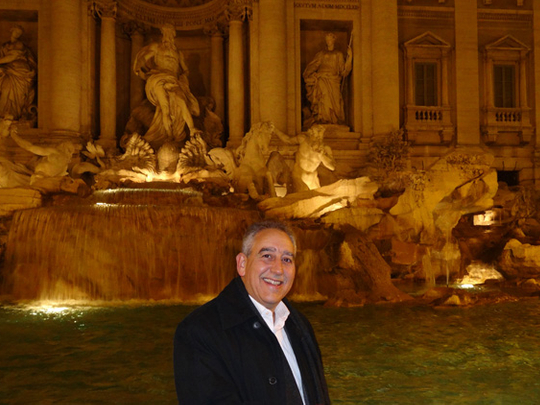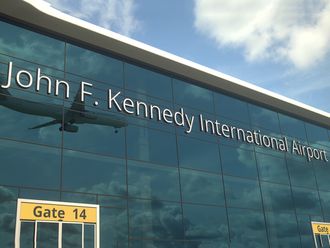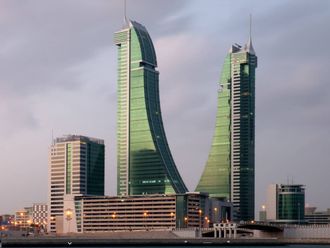
Manama: When Samer Majali, Gulf Air chief executive officer, closed his eyes and threw the euros with his right hand over his left shoulder for the second time in Rome's Trevi Fountain, his wish was that not only he would come back to the Eternal City, but also numerous Gulf Air crews, and for years to come.
The Jordan-born executive has been to Italian capital before, a city that he loved to the core. He liked being in a proud city that carries its long rich history of over 3,000 years with dolce vita lightness.
He was profoundly in love with its classical ruins next to its Renaissance palazzos and Baroque fountains. He admired its buzzing scenes, fantastic sights and lovely shops and enjoyed its splendid grandeur and Mediterranean weather.
This time, one more special thing pulled Samer to Rome: Gulf Air had made history by launching direct flights to the eternal city. Italy was the only country in Europe where Gulf Air had two destinations. The first flight was to Milan, the fashion capital and financial hub, now followed by a direct route to the Italian capital.
He was confident that the company had made a wise choice that would help connect between East and West, between Asia, Europe and, by extension, Africa and the Americas.
Gulf Air has gained a new reputation for offering a wide choice of transit options that enabled travelers to fly at the time they liked, and not as dictated by the airliner.
For Samer, an eternal optimist, looking forward meant reinforcing this choice. The aviation industry was going through turbulent times, and his insistence to soar high meant pragmatic solutions and practical options.
Looking at the fountain again, he wanted to move on, well aware that he had a dinner appointment. But, he felt so enchanted that he allowed himself some more minutes to take in again the iconic fountain and the Palazzo Poli in the background.
He loved staring at the Tritons guiding Oceanus' shell chariot, at Abundance spilling water from her urn and Salubrity holding a cup from which a snake drinks. It was a great sight.
Noof Bu Allay, the Gulf Air media expert, a few metres away, seemed to appreciate her boss' open penchant for the fountain.
Licking a cone of splendid granita gelato while sitting on the steps, she was equally amazed by the sight of the extravagant Baroque style of the Fontana and by the enthusiasm shown by hundreds of visitors as they converged irresistibly towards the waters or threw coins.
Her mind raced to the scene of the 1960 Dolce Vita movie where Marcello and Maddalena reach the harmonious proportions of the Fountain.
She has repeatedly watched the movie and could easily reenact the magic moments by the frame.
Noof has been to Milan and loved the sophistication and modernism of the city. In Rome, she was overwhelmed with history and civilization. And she admired every bit of it.
Having lived in Tunisia, she was quite familiar with Roman history and influence on several Mediterranean countries.
But here in Rome, a city that has over almost 3,000 years of continuous existence grown from a small village to the centre of a vast civilization, history is fully of glory and expectedly holds a special significance for both residents and visitors.
"We have reached a point where we are afraid of digging anywhere in the city," Marinella Prudenza, a tourist guide said. "There are concerns that we will unearth some archaeological walls or rooms and that means that we cannot use the land privately," she said.
For Noof, excavation and restoration amid the hubbub of a special city should not stall her determination to reach the Colosseum, the half circus, half sports arena overlooking Rome's historic centre.
She felt a dream has come true. After she marveled at the most impressive building of the Roman Empire, she moved inside and lived in her mind scenes almost 2,000 years old when determined gladiators and wild beasts fought for survival while 45,000 people cheered.
She could now appreciate why the Colosseum's design inspired the construction of over 250 amphitheaters across the Roman Empire. It was one of the most dramatic ways to reinforce the image of Rome as a powerful city.
Not far away, the magnificent Pantheon building still stands as another reminder of the grandeur of ancient Rome.
Built more than 1800 years ago originally as a temple for all pagan gods, the temple was converted into a church in 609. The perfectly harmonious building where the distance from the floor to the top of the dome is exactly equal to its diameter today contains the tombs of famous artists Raphael and Annibale Carracci and of Italian Kings Vittorio Emanuele II and Umberto I.
However, a visit to Rome is never complete with a trip to Vatican City, the world capital of Catholicism and the world's smallest state. Around 500 people live in the city that has been sovereign since 1929 and has its own judicial system, post office, banks, currency, radio station, shops and a daily newspaper.
The Vatican Museums are home to the Sistine Chapel and its ceiling frescoed by Michelangelo for Pope Julius II between 1508 and 1512, and to some of the world's most important art collection.












